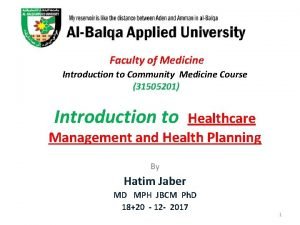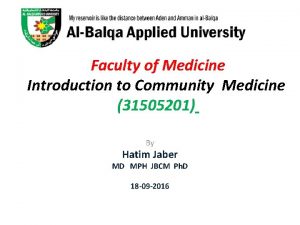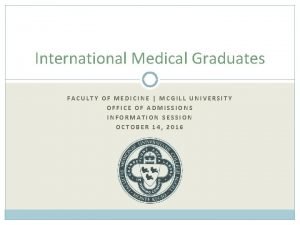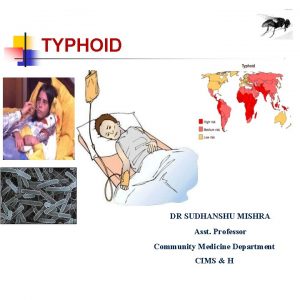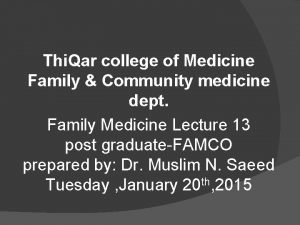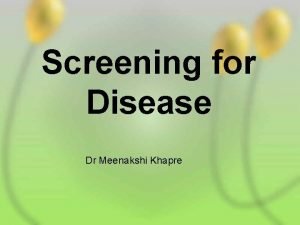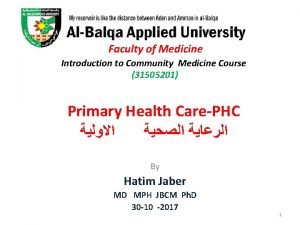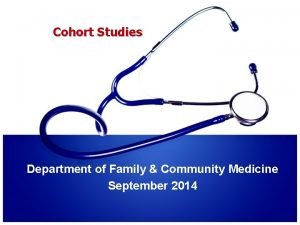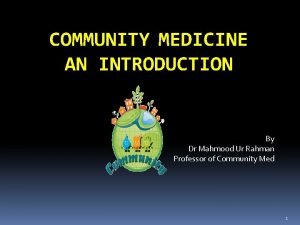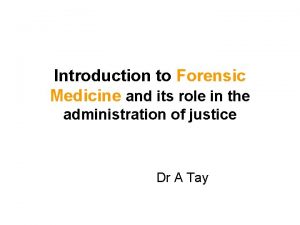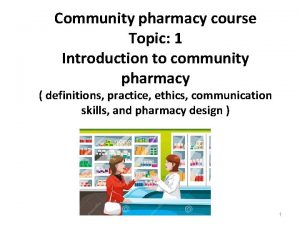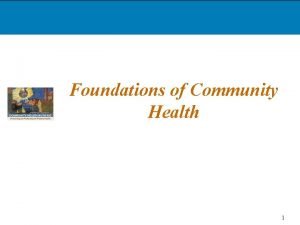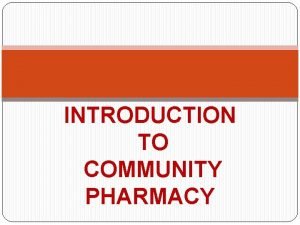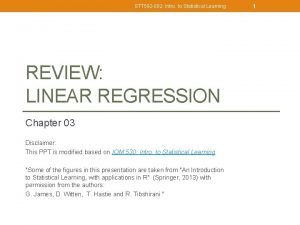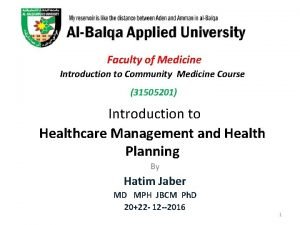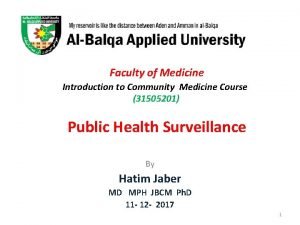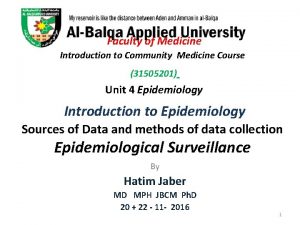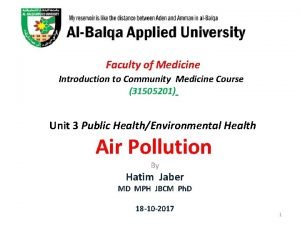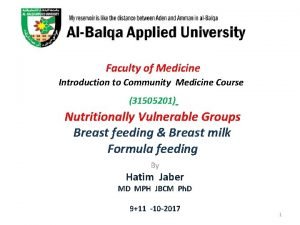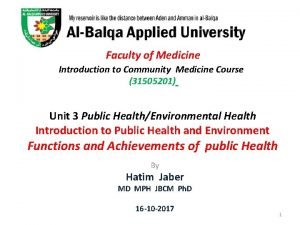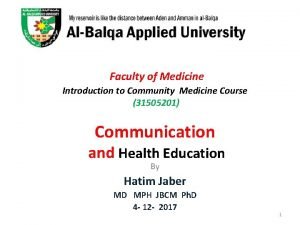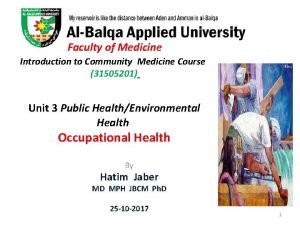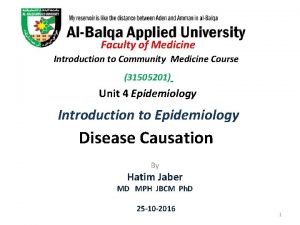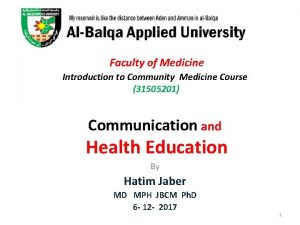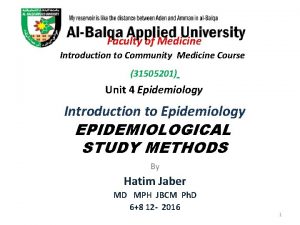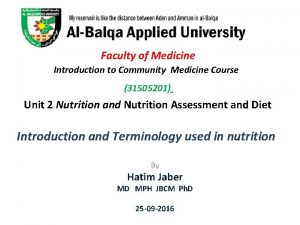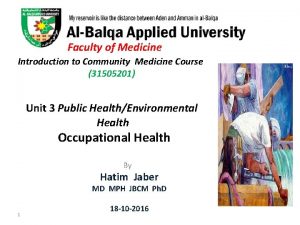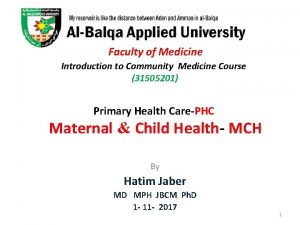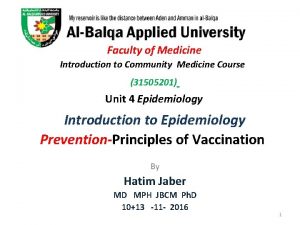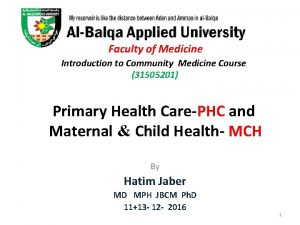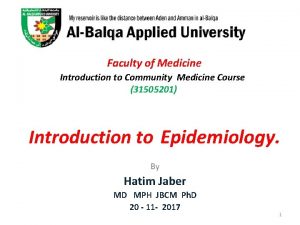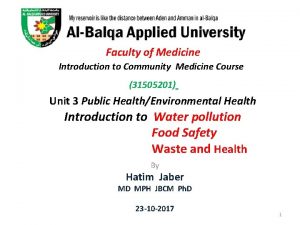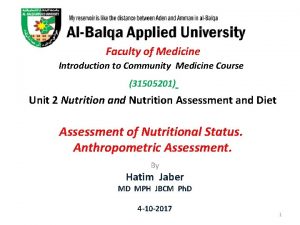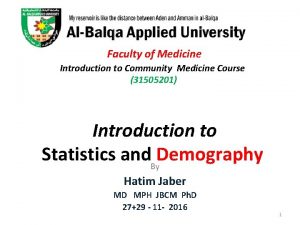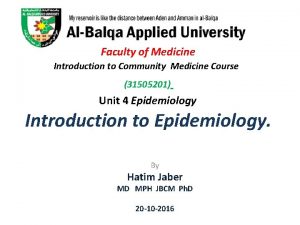Faculty of Medicine Introduction to Community Medicine Course

















































- Slides: 49

Faculty of Medicine Introduction to Community Medicine Course (31505201) Unit 2 Nutrition and Nutrition Assessment and Diet The Nutrients & their Categories. By Hatim Jaber MD MPH JBCM Ph. D 27 -09 -2016

Attention!!!! • • Week 2 Unit 2 Nutrition and Nutrition Assessment and Diet Sun 25 -9 Introduction and Terminology used in nutrition Tue 27 -9 The Nutrients & their Categories Thu 29 -9 Spectrum of public nutrition problems: Malnutrition & its Ecology and Common nutritional disorders in Jordan • Week 3 Unit 2 (cont. ) Nutrition and Nutrition Assessment and Diet • Sun 2 -10 =================== • Tue 4 -10 Assessment of Nutritional Status. Anthropometric Assessment. • Thu 6 -10 Breast feeding & Breast milk. Formula feeding

Presentation outline Time Nutrients classifications 12: 00 to 12: 10 Macronutrients and their functions 12: 10 to 12: 30 Micronutrients and their functions 12: 30 to 12: 40 Water , vitamins and minerals 12: 40 to 12: 50

Background definitions • Nutrients: “Chemical substances in food that nourish the body by providing energy, building materials, and factors to regulate needed chemical reactions. ” • (Organic and inorganic complexes contained in food are called nutrients). • Essential nutrients: Must be provided by food because the body does not produce them in sufficient quantities or can not make them at all. • Nonessential nutrients: Healthy, well-nourished bodies can make them in sufficient quantities to satisfy their needs.

The Nutrients Copyright 2005 Wadsworth Group, a division of Thomson Learning

Nutrients are classified into : • A. Macronutrients (carbohydrates, fats, and proteins). 1. Provide calories for energy 2. Needed in large quantities • B. Micronutrients (vitamins, minerals, and water). Needed in smaller amounts

Six categories of nutrients 1. Carbohydrates: contain carbon, hydrogen, and oxygen combined in small molecules called sugars and large molecules represented mainly by starch. 2. Lipids (fats and oils): contain carbon, hydrogen, and oxygen as do carbohydrates, but the amount of oxygen is much less. Triglyceride is the main form of food fat. 3. Proteins: contain carbon, hydrogen, and oxygen, plus nitrogen and sometimes sulfur atoms arranged in small compounds called amino acids. Chains of amino acids make up dietary proteins.

Six categories of nutrients (cont’d): 4. Vitamins: are organic compounds that serve to catalyze or support a number of biochemical reactions in the body. 5. Minerals: are inorganic elements or compounds that play important roles in metabolic reactions and serve as structural components in body tissues such as bone. 6. Water: is vital to the body as a solvent and lubricant and as a medium for transporting nutrients and waste.

about 45 essential nutrients

Energy and food • The energy in foods is expressed as kilocalories. One kilocalorie represents the amount of heat it takes to raise the temperature of one liter of water 1°C • A person needs about 2000 kilocalories a day to meet his or her energy needs. In common usage, people refer to kilocalories as calories, which is a much smaller energy unit: 1 kilocalorie contains 1000 calories.

Carbohydrates • There are three types- sources of carbohydrates food sugar, starch and cellulose • 1 - Sugar: Sugar is also called simple carbohydrate. Fruits, honey and sugar are some sources of sugar. • 2 - Starch: starch is called complex sugar. Plants store energy in the form of starch. When we eat plant products containing starch, our digestive system breaks down starch into glucose. This glucose is absorbed in blood and provides energy. Some foods give carbohydrates to our body in the form of starch. These are cereals, potatoes, sweet potatoes etc. Some other foods give carbohydrates in the form of sugar. For example sugar, honey, jam, jiggery, etc. Starch and sugar are the main source of energy and essential for synthesis of certain non-essential amino acids • 3 - Cellulose: complex carbohydrates not digested but form the bulk of stools. ---Optimum requirement of carbohydrate in balanced diet 50 -70%of total energy intake. • One gram of carbohydrate gives four kcal. • An adult person needs 400 -420 gms of carbohydrates everyday.

Carbohydrates are classified into: • Monosaccharide are seldom found free in nature and are the simplest form of carbohydrate. • Disaccharides and polysaccharides consist of monosaccharide linked together. • Also carbohydrates are classified into simple and complex carbohydrates.

• Monosaccharides: Glucose (blood sugar), Fructose(fruit), Galactose (milk) • Disaccharides: Sucrose (table sugar=glucose and fructose), Lactose(milk- glucose and galactose), Maltose • Polysaccharides: (Starch in plants and Glycogen in human and animals) - Digestible: Amylose, Amylopectin, Resistant starch, Dextrins and Glycogen (animal carbohydrate) - Indigestible: dietary fibers: cellulose, pectin, gums….

Dietary Fiber and Functional Fiber • • Cellulose Beta-glucans Chitin and chitosan Hemicellulose Pectins, gums, and mucilages Fructans Algal polysaccharides Lignin

Role of Fiber in Digestion and Absorption • • Prevent constipation Increase fecal volume Decrease GI transit time Slowed or decreased nutrient absorption Bind cholesterol and minerals Reduce the risk of cancer and GBS Modify serum lipid concentrations – Short-chain fatty acids

Glycemic Index (GI) • Is the blood glucose response to a given food, compared to standard food (glucose or white bread) • Relative ability of different dietary carbohydrates to raise blood glucose levels • Advantages of foods with low glycemic index (GI)


Functions of Carbohydrates Sources -Give energy and feeling of fullness -increase the bulk of our food. -Spare proteins to perform other functions -Helps to make the food tasty. - Prevent ketosis Starch sources: cereals – like wheat rice, bajra, maize, potatoes, sweet potatoes, calocasia, etc. sugar sources: sugar, honey, jaggery, sweets, jam, murabba, etc.

Proteins Are nitrogenous compounds, composed of amino acids Complete proteins: • Foods containing all the essential amino acids Examples: fish, meat, eggs, milk, cheese Incomplete proteins: • Foods that are missing some essential amino acids Examples: Legumes, nuts, whole grains

Amino Acids and Protein • Essential amino acids • Nonessential amino acids • 9 of the 20 amino acids are called essential amino acids because you must obtain them from the foods you eat since your body cannot make them.

Structure and Function of the 20 Amino Acids Required by Humans Amino acids marked with an asterisk (*) are essential.

Structure and Function of the 20 Amino Acids Required by Humans–cont’d Amino acids marked with an asterisk (*) are essential; those with a double asterisk (**) are essential in infants and in chronic diseases.

Structure and Function of the 20 Amino Acids Required by Humans–cont’d Amino acids marked with an asterisk (*) are essential; those with a double asterisk (**) are essential in infants and in chronic diseases.

Dietary Protein Quality • Limiting amino acid • Net protein utilization • Protein digestibility corrected amino acid score (PDCAAS) • Denaturation • Vegetable vs animal protein • Food processing • Complementary proteins

• High biological value protein(HBV protein): any HBV protein in adequate amount provides the body needs of amino acids ___ all animal proteins are HBV except gelatin • Low biological value protein(l. BV protein) where some of essential amino acids are either missing or of inadequate amount== all plant except soybeans

Reference protein • Ideal protein – is protein that fulfils the following theoretical criteria: - contains all essential amino acids in optimal amount for human being - fully digestible and utilizable by the body>

Functions • • • Formation cells: cytoplasm Formation essential biological compounds : Hb Regulation of fluids movement: osmotic pressure Regulation the acid-base balance: as buffers Supporting immune system: antibody Production of energy: 4 kcal


Fats • Fats are groups of insoluble compounds and include: - Fatty acids - Triglycerides (glycerol: sugar alcohol+3 fatty acids) 95% of dietary fat = energy and storage - Phospholipids: one phosphat +2 fatty acids ( brain, hormones and corticosteroids…) - Cholesterols: LDL and HDL

cholesterol A waxy substance found in the blood and cells and needed for synthesis of cell membranes, vitamin D, and hormones. low-density lipoprotein (LDL) Blood fat that transports cholesterol to organs and tissues; excess amounts result in the accumulation of fatty deposits on artery walls. • high-density lipoprotein (HDL) Blood fat that helps • transport cholesterol out of the arteries, thereby protecting • against heart disease. • • •

Types of Lipids • Triglycerides • Phospholipids (e. g. , lecithin) • Sphingolipids, alcohols, waxes, isoprenoids, and steroids (including cholesterol) • Glycolipids • Synthetic lipids (MCT, structured lipids, fat replacers)

Other Lipid Issues: Eicosanoid Synthesis

Fatty Acids ---essential acids to be supplied in food • • Saturated (SFA) Monounsaturated (MFA) Polyunsaturated (PUFA) Location of double bonds; how named: – Omega-6 – Omega-3 • Essential fatty acids

Trans-Fatty Acids Repeated heating UFA(plant)---TFA • Trans versus cis format • Sources of trans-fatty acids – Partially hydrogenated margarine, shortening, commercial frying fat, high-fat baked goods, salty snacks • Negative health effects: +LDL, -HDL, neonatal…

Lipids • Functions – Energy (9 kcal/g) – Organ positioning, protection – Fat-soluble vitamins and phytochemicals



• • • • dietary fi ber Nondigestible carbohydrates and lignin that are intact in plants. functional fi ber Nondigestible carbohydrates either isolated from natural sources or synthesized; these may be added to foods and dietary supplements. total fi ber The total amount of dietary fi ber and functional fi ber in the diet. soluble (viscous) fi ber Fiber that dissolves in water or is broken down by bacteria in the large intestine. insoluble fi ber Fiber that does not dissolve in water and is not broken down by bacteria in the large intestine. vitamins Carbon-containing substances needed in small amounts to help promote and regulate chemical reactions and processes in the body.

Vitamins • Vitamins are organic (carbon-containing) substances required in small amounts to regulate various processes within living cells • Humans need 13 vitamins; of these, four are fat -soluble (A, D, E, and K), and nine are watersoluble (C and the B-complex vitamins thiamin, r ibofl avin, niacin, vitamin B-6, folate, vitamin B 12, biotin, and pantothenic acid).



Minerals—Inorganic Micronutrients • Minerals are inorganic (non-carbon-containing) elements you need in relatively small amounts to help regulate body functions, aid in the growth and maintenance of body tissues, and help release energy

• Function: Assists with the transport of materials in the body by making up most of the liquid part of blood (plasma), helps regulate body temperature, and helps break down food in the digestive system • Food sources: vegetables, fruit, milk



Water—Vital but Often Ignored • Water is the major component in both foods and the human body: You are composed of about 50– 60% water. • You can live up to 50 days without food but only a few days without water.

Other Substances in Food • Antioxidants When the body uses oxygen or breaks down certain fats or proteins as a normal part of metabolism, it gives rise to substances called free radicals • free radical An electron-seeking compound that can react with fats, proteins, and DNA, damaging cell membranes and mutating genes in its search for electrons; produced through chemical reactions in the body and by exposure to environmental factors such as sunlight and tobacco smoke.

Daily exercise and weight control

 Introduction to community medicine
Introduction to community medicine Introduction to community medicine
Introduction to community medicine Hubert kairuki memorial university faculty of medicine
Hubert kairuki memorial university faculty of medicine Hyperparathyreosis
Hyperparathyreosis Faculty of medicine nursing and health sciences
Faculty of medicine nursing and health sciences Applied medical sciences
Applied medical sciences Territorial matrix vs interterritorial matrix
Territorial matrix vs interterritorial matrix Faculty of veterinary medicine cairo university logo
Faculty of veterinary medicine cairo university logo Hacettepe university faculty of medicine
Hacettepe university faculty of medicine Auricle of heart vs atrium
Auricle of heart vs atrium Semmelweis university faculty of medicine
Semmelweis university faculty of medicine Faculty of medicine mcgill
Faculty of medicine mcgill Faculty of veterinary medicine cairo university
Faculty of veterinary medicine cairo university Pubh4401
Pubh4401 Emory dermatology clinic
Emory dermatology clinic Cairo university faculty of veterinary medicine
Cairo university faculty of veterinary medicine Faculty introduction speech
Faculty introduction speech Disadvantages of cavity wall
Disadvantages of cavity wall Course number and title
Course number and title Course interne moyenne externe
Course interne moyenne externe Typhoid medicine course
Typhoid medicine course Lt lead time
Lt lead time Types of family in community medicine
Types of family in community medicine Concept of lead time
Concept of lead time Kashif rahim
Kashif rahim Elements of primary health care
Elements of primary health care Cohort study community medicine
Cohort study community medicine Duke medicine grand rounds
Duke medicine grand rounds Seqs community medicine
Seqs community medicine Community action cycle for community mobilization
Community action cycle for community mobilization Introduction to banking course
Introduction to banking course Imbe introduction course v2
Imbe introduction course v2 Software engineering 1 course outline
Software engineering 1 course outline Pied piping
Pied piping Cleft sentences examples
Cleft sentences examples Awe aldermaston
Awe aldermaston Introduction to forensic medicine
Introduction to forensic medicine Introduction of community policing
Introduction of community policing The apprentice pharmacist
The apprentice pharmacist Characteristics of community health nursing
Characteristics of community health nursing An introduction to community asset mapping
An introduction to community asset mapping Community asset mapping examples
Community asset mapping examples Introduction to community pharmacy
Introduction to community pharmacy University of split faculty of maritime studies
University of split faculty of maritime studies University of bridgeport engineering
University of bridgeport engineering University of bridgeport computer science
University of bridgeport computer science Alamo colleges faculty salary schedule
Alamo colleges faculty salary schedule Hahnville high school powerschool
Hahnville high school powerschool Importance of faculty in higher education
Importance of faculty in higher education Faculty marshall usc advertising csv
Faculty marshall usc advertising csv
